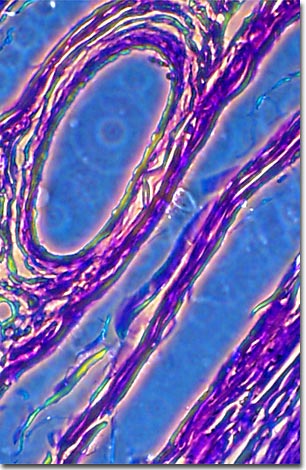Phase Contrast Image Gallery
Coronary Atherosclerosis
A stained thin section of human heart tissue afflicted with atherosclerosis is illustrated in the photomicrograph presented below. As evidenced by the micrograph, combining phase contrast microscopy with classical histological staining techniques in pathological research often yields enhancement of cellular features.

Atherosclerosis is a form of arteriosclerosis, or hardening of the arteries. Atherosclerosis results from the gradual build-up of cholesterol and calcifications (plaque) inside the arteries. Cholesterol is essential to good health because it's a component of cellular membranes. However, if there is too much in the blood or someone has inherited a tendency to develop atherosclerosis, cholesterol can wind up being inappropriately deposited on the walls of the arteries.
Coronary atherosclerosis is the partial or total blockage of the arteries feeding blood to the heart and is one of the most common cardiovascular diseases in the developed nations of the world. Once thought to be a normal consequence to aging, recent evidence links atherosclerosis closely to diet and lifestyle, suggesting that it might be entirely prevented in many people or at least slowed in its development. Currently, heart disease is the number one cause of deaths in the United States.
Angina pectoris, a dull chest pain, is one symptom of coronary atherosclerosis and is caused by the decreased blood flow to the heart due to narrowing of the arteries. Arteries that become completely blocked can cause the death of heart tissue, or myocardial infarction, which can be fatal in severe cases. Although there are surgical treatments for opening up blockages and replacing damaged arteries, prevention through diet, exercise, and lifestyle changes is being strongly advocated by the health care professionals.
BACK TO THE PHASE CONTRAST GALLERY
